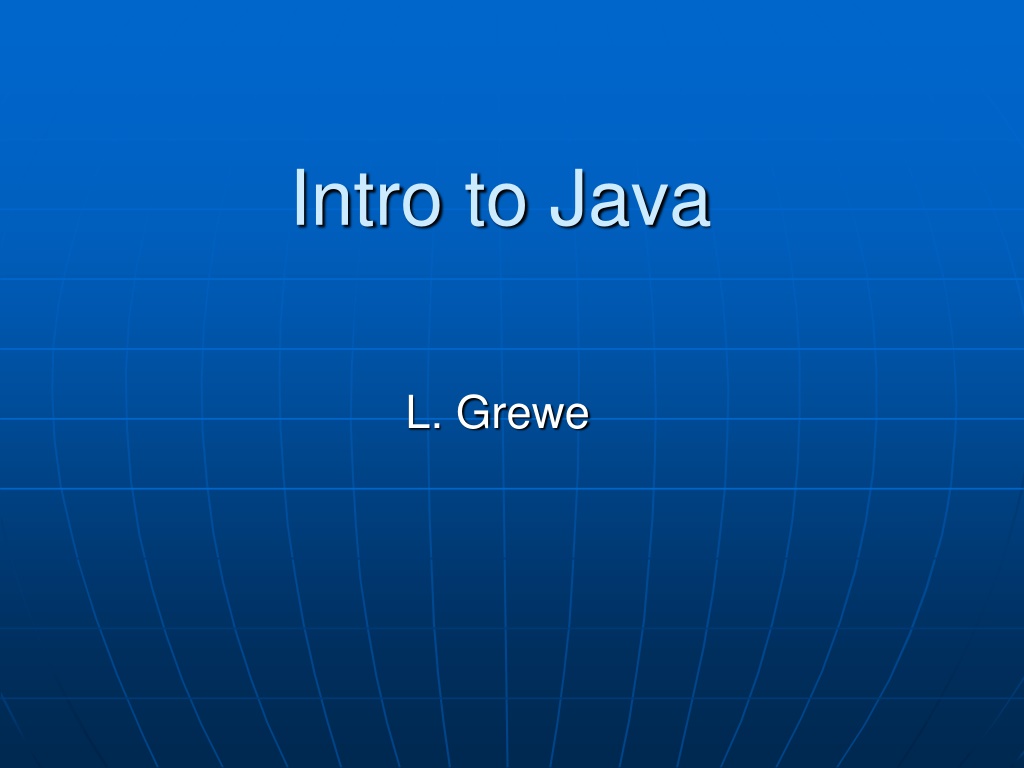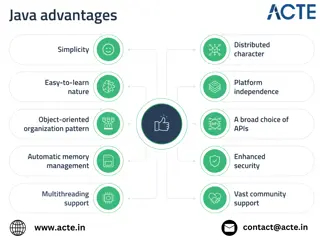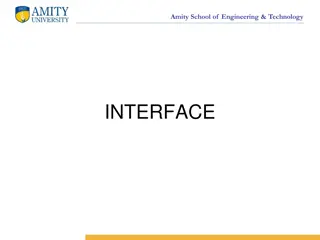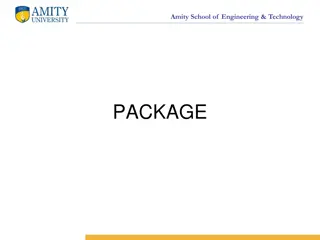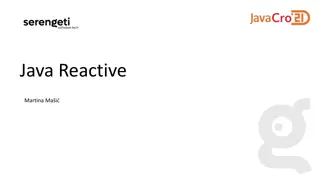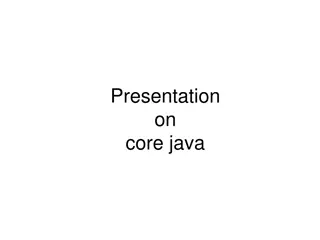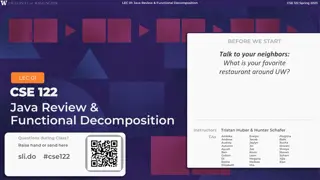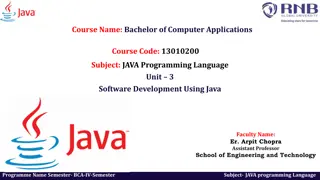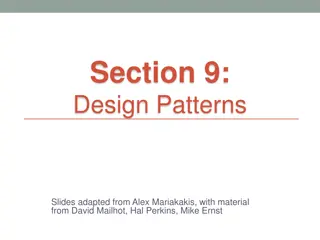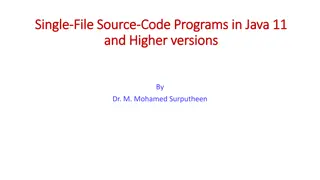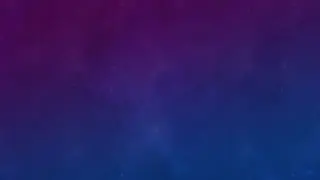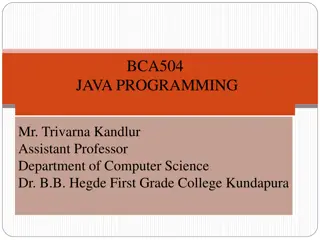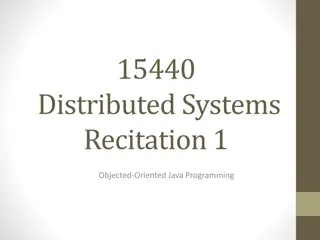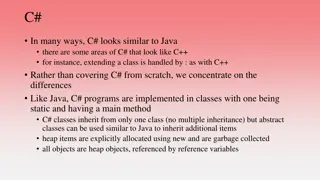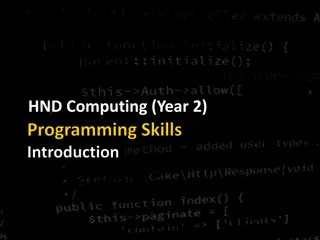Overview of Java Programming Language
Java is a versatile and powerful programming language created by James Gosling and others at Sun Microsystems in the 1990s. It aims for portability, reliability, safety, simplicity, and efficiency. With a strong focus on object-oriented programming, Java has evolved over the years with a rich history of releases and enhancements, making it a popular choice for a wide range of applications. The language features characteristics such as simplicity, portability, reliability, safety, and a comprehensive system that includes a compiler, run-time environment, and a vast library. Java's release history includes significant milestones like the introduction of inner classes, generics, annotations, and more. Enhancements since JDK 5 have further improved Java's capabilities with features like generics, enhanced for loop, autoboxing, typesafe enums, varargs, static import, and concurrency utility library.
Download Presentation

Please find below an Image/Link to download the presentation.
The content on the website is provided AS IS for your information and personal use only. It may not be sold, licensed, or shared on other websites without obtaining consent from the author.If you encounter any issues during the download, it is possible that the publisher has removed the file from their server.
You are allowed to download the files provided on this website for personal or commercial use, subject to the condition that they are used lawfully. All files are the property of their respective owners.
The content on the website is provided AS IS for your information and personal use only. It may not be sold, licensed, or shared on other websites without obtaining consent from the author.
E N D
Presentation Transcript
Intro to Java L. Grewe
Java history James Gosling and others at Sun, 1990 - 95 Internet application simple language for writing programs that can be transmitted over network
Some Goals Portability Internet-wide distribution: PC, Unix, Mac Reliability Avoid program crashes and error messages Safety Programmer may be malicious Simplicity and familiarity Appeal to average programmer; less complex than C++ Efficiency Important but secondary
Characteristics Simplicity Everything an object All objects on heap, accessed through pointers no functions no multiple inheritance, no operator overloading Portability Bytecode interpreter on many platforms Reliability and Safety Run-time type and bounds checks Garbage collection
Java System The Java programming language Compiler and run-time system Programmer compiles code Compiled code transmitted on network Receiver executes on interpreter (JVM) Safety checks made before/during execution Library, including graphics, security, etc. Large library Interoperability Provision for native methods
Java Release History 1995 (1.0) First public release 1997 (1.1) Inner classes 2001 (1.4) Assertions Verify programmers understanding of code 2004 (1.5) Tiger Generics, foreach, Autoboxing/Unboxing, Typesafe Enums, Varargs, Static Import, Annotations, concurrency utility library 2006 (1.6) SE 6
Enhancements since JDK 5 (= Java 1.5) Generics Polymorphism and compile-time type safety (JSR 14) Enhanced for Loop For iterating over collections and arrays (JSR 201) Autoboxing/Unboxing Automatic conversion between primitive, wrapper types (JSR 201) Typesafe Enums Enumerated types with arbitrary methods and fields (JSR 201) Varargs Puts argument lists into an array; variable-length argument lists Static Import Avoid qualifying static members with class names (JSR 201) Annotations (Metadata) Enables tools to generate code from annotations (JSR 175) Concurrency utility library
Language Terminology Class, object Field data member Method - member function Static members - class fields and methods this - self Package - set of classes in shared namespace Native method - method written in another language, often C
Java Classes and Objects Syntax similar to C++ Object has fields and methods is allocated on heap, not run-time stack accessible through reference (only ptr assignment) garbage collected Dynamic lookup Similar in behavior to other languages Static typing => more efficient than Smalltalk Dynamic linking, interfaces => slower than C++
Template for Class Definition Import Statements Class Comment class { Class Name Fields/Variables Methods (incl. Constructor) }
Point Class class Point { private int x; protected void setX (int y) {x = y;} public int getX() {return x;} Point(int xval) {x = xval;} // constructor };
Object initialization Java guarantees constructor call for each object Memory allocated Constructor called to initialize memory Some interesting issues related to inheritance
Garbage Collection and Finalize Objects are garbage collected No explicit free Avoids dangling pointers and resulting type errors Problem What if object has opened file or? Solution finalize method, called by the garbage collector Before space is reclaimed, or when virtual machine exits
Encapsulation and packages Every field, method belongs to a class Every class is part of some package Can be unnamed default package File declares which package code belongs to package class field method package class field method
Access Four access distinctions public, private, protected, package Method can refer to private members of class it belongs to non-private members of all classes in same package protected members of superclasses (in diff package) public members of classes in visible packages Visibility determined by files system, etc. (outside language) Qualified names (or use import) java.lang.String.substring() method class package
Inheritance Similar to Smalltalk, C++ Subclass inherits from superclass Single inheritance only (but Java has interfaces)
Example subclass class ColorPoint extends Point { // Additional fields and methods private Color c; protected void setC (Color d) {c = d;} public Color getC() {return c;} // Define constructor ColorPoint(int xval, Color cval) { super(xval); // call Point constructor c = cval; } // initialize ColorPoint field };
Class Object Every class extends another class Superclass is Object if no other class named Methods of class Object GetClass return the Class object representing class of the object ToString returns string representation of object equals default object equality (not ptr equality) hashCode Clone makes a duplicate of an object wait, notify, notifyAll used with concurrency finalize
Constructors and Super Java guarantees constructor call for each object Different conventions for finalize and super Compiler does not force call to super finalize
Final classes and methods Restrict inheritance Final classes and methods cannot be redefined Example java.lang.String Reasons for this feature Important for security Programmer controls behavior of all subclasses Critical because subclasses produce subtypes Compare to C++ virtual/non-virtual Method is virtual until it becomes final
Call-by-Value Parameter Passing When a method is called, value of argument is passed to the matching parameter, separate memory space is allocated to store this value. This way of passing the value of arguments is called a pass-by-value Since separate memory space is allocated for each parameter during the execution of the method, the parameter is local to the method, changes made to the parameter will not affect the value of the corresponding argument.
Java Types Two general kinds of types Primitive types not objects Integers, Booleans, etc Reference types Classes, interfaces, arrays No syntax distinguishing Object * from Object
Classification of Java types Reference Types Object Object[ ] Throwable Shape Shape[ ] Exception types Circle Square Circle[ ] Square[ ] user-defined arrays Primitive Types boolean int byte float long
Arrays Automatically defined Can have for primitive types and objects. Multi-dimensional arrays T[ ] [ ] Treated as reference type An array variable is a pointer to an array, can be null Example: Circle[] x = new Circle[array_size] Every array type is a subtype of Object[ ], Object Length of array is not part of its static type
Interface example interface Shape { public float center(); public void rotate(float degrees); } interface Drawable { public void setColor(Color c); public void draw(); } class Circle implements Shape, Drawable { // does not inherit any implementation // but must define Shape, Drawable methods }
Interfaces Flexibility Black box design .specify input/output but, not internals.
Java Exceptions Similar basic functionality to C++ Constructs to throw and catch exceptions Dynamic scoping of handler Some differences An exception is an object from an exception class Subtyping between exception classes Use subtyping to match type of exception or pass it on Type of method includes exceptions it can throw
Exception Classes Throwable Runtime Exception Exception Error checked exceptions User-defined exception classes Unchecked exceptions If a method may throw a checked exception, then this must be in the type of the method
Try/finally blocks Exceptions are caught in try blocks try { statements } catch (ex-type1 identifier1) { statements } catch (ex-type2 identifier2) { statements } finally { statements }
Keyword this" Object can use to refer to itself. Can use to refer to its variables see example. class Person { } int age; public void setAge(int val) { this.age = val; } . . .
Overloaded Methods Methods can share the same name as long as different number of parameters (Rule 1) or their parameters are of different types when the number of parameters is the same (Rule 2) public void myMethod(int x, int y) { ... } Rule 1 public void myMethod(int x) { ... } public void myMethod(double x) { ... } Rule 2 public void myMethod(int x) { ... }
Simple Console Application Lets create Hello World in Java Single class Contains VERY special method with signature: public static void main(String args) { //your code here }
Simple Console Application Here we see it in Eclipse
